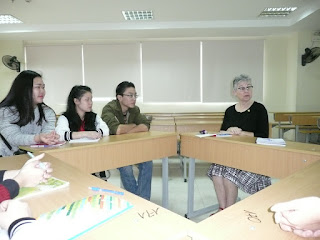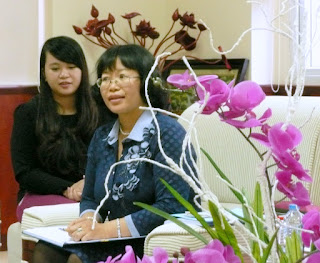Been a bit of time since I posted any blog, health issues and all made me step aside for a while. Have been following the news from Vietnam and about Vietnam, Obama's visit and the appointment of the war criminal Bob Kerry as the President of a US University in Vietnam to be run by the Fullbright folks. Why they would put up as President a man who personally ordered the slaughter of children, women, men and old folks is hard to understand unless the message is: the Vietnam nation will do it our US way or else. We don't care about the slaughters and the Agent Orange, napalm, carpet bombing, bombing dikes and flooding villages and destroying food stockpiles and other atrocities.
And from what the US press I can't see that Obama brought any message of "we are truly sorry for what we inflicted on your country and the 2 to 4 million people that we helped kill or killed ourselves."
Sunday, June 26, 2016
Wednesday, January 13, 2016
Students organize Blood Drive and students and faculty give!
 Campuses across Vietnam have blood drives at several times during the year and the Women's Academy students organized a drive and it was held while we were visiting here. They set up the tent and other logistics the night before and then staffed it on Tuesday. Although we had a workshop earlier in the day we got down out there to get a few pictures.
Campuses across Vietnam have blood drives at several times during the year and the Women's Academy students organized a drive and it was held while we were visiting here. They set up the tent and other logistics the night before and then staffed it on Tuesday. Although we had a workshop earlier in the day we got down out there to get a few pictures.  The students were delighted to have their Blood Drive photographed and we told them it would be on our blog to let our friends know what a good experience it was.
The students were delighted to have their Blood Drive photographed and we told them it would be on our blog to let our friends know what a good experience it was.
Meeting with Women's Academy students and talking about family, hobbies and fun time.
Every Vietnamese student likes to have fun, who doesn't? When we got together with a group of the students on Tuesday this week we talked about what they like to do for fun, what is their family like, and what hobbies do they pursue, if any? Several of the families had four members: mother, father,brother or sister and our student and about 1/2 of the students' families live in Hanoi.
Some of their fun and hobbies go together like salt and pepper: For example many students like listening to music with their friends or by themselves when studying. Others liked movies, fishing, sports, and hanging out with friends to chat at "sidewalk cafes". Several of the students were from rural provinces where their families farm.
Some of their fun and hobbies go together like salt and pepper: For example many students like listening to music with their friends or by themselves when studying. Others liked movies, fishing, sports, and hanging out with friends to chat at "sidewalk cafes". Several of the students were from rural provinces where their families farm.
US LABOR DELEGATION VISIT TO WOMEN'S ACADEMY
 |
| President Mr. Tran Quang Tien of Vietnam Women's Academy and Professor Mr. Kent Wong of the UCLA Labor Center, our co-chairs for the meeting. |
 On Monday afternoon, 11-1-2016, the US Labor Delegation organized by Kent Wong visited the Women's Academy for a very lively and friendly discussion about the Academy, the Vietnam Women's Union and chat about active women and feminists: the same or different in the USA. The delegation totaled 13 labor leaders and in a future blog we will present all the names as well as the names of our Vietnam friends who were present. Mr. President Tran Quang Tien of the VWA and Mr. Kent Wong, Director of the UCLA Labor Center co-chaired the meeting in expert fashion assuring everyone a chance to be recognized, ask questions or comment on points. For many of the delegation this was their first time in Vietnam and they relished the chance to ask questions, learn from their hosts and giver their opinions and speak to their experience in labor and gender issues.
On Monday afternoon, 11-1-2016, the US Labor Delegation organized by Kent Wong visited the Women's Academy for a very lively and friendly discussion about the Academy, the Vietnam Women's Union and chat about active women and feminists: the same or different in the USA. The delegation totaled 13 labor leaders and in a future blog we will present all the names as well as the names of our Vietnam friends who were present. Mr. President Tran Quang Tien of the VWA and Mr. Kent Wong, Director of the UCLA Labor Center co-chaired the meeting in expert fashion assuring everyone a chance to be recognized, ask questions or comment on points. For many of the delegation this was their first time in Vietnam and they relished the chance to ask questions, learn from their hosts and giver their opinions and speak to their experience in labor and gender issues.In short, the discussion was free ranging and as someone commented it was a joy to trade information and learn from each other on important issues for Vietnam, the USA and the World.


The discussion was wide ranging covering some history of the Women's Union - VWU, organized in 1930, and a strong player in the successful struggle for national independence and, too, the history of the Academy referred to also as the VWA. Here is a link to the history of the VWA:
http://hvpnvn.edu.vn/bai-viet/gioi-thieu/lich-su-hinh-thanh-hoc-vien-phu-nu-viet-nam-1379.htm
The VWA was founded by the VWU in 1960 during the intensity of the American war [For those unaware, the US war effort in VN began years before 1963.] to educate and train women in a variety of work in government and social affairs. [FYI: if the writer is wrong on points it is not by intention but hearing difficulties sometimes make it hard to get things perfectly on point.] Since that time the Academy has brought education and skills to thousands of government workers as well as the staff of the Women's Union and other organizations and continues to do so with its expanded and expanding programs of education. Just this past September two new departments were added to the educational work: 1.Law and 2.Gender and Development to join the existing faculties of 3.Social Work and 4.Business Administration. There are about 1000 students served at this campus with many living in a dormitory and others who commute to their studies. Besides the educational work at the campus the faculty also travels to widespread local sites where they conduct seminars and training for women's organizations including local membership organizations of the Women's Union. FOR CLARIFICATION: THE WOMEN'S UNION IS NOT A TRADE OR LABOR UNION BUT A VERY STRONG AND CAPABLE ORGANIZATION THAT BRINGS AND KEEPS WOMEN'S ISSUES ON THE AGENDA OF THE NATION. As a member of the Fatherland Front the WU is a perpetual participant in the deliberations of policy for the nation and can and does bring woman centered policy proposals forward to benefit national development and women's place in society. It was explained that the WU has organizations in villages, communes, provincial and city governments and of course there is the national organization. The Vietnam Constitution guarantees the equal rights and status of women and the WU is the organization that sees that the role of women is maintained and develops.
Visit to Lo, a beautiful village between Hanoi and Hai Phong
 |
| One of the old watch houses used to keep the village safe in event of floods, now no longer used but keptlocked and secure. |
 | |||||
Incidentally, now there are flood control dams and the peasants do not have to stand guard at the watch boxes along the top of the dikes to give warning in case of flooding. The sleeping/office rooms are still there but they are locked.
 |
| Kids and TET decorations. |
 |
| TET decorations made at one of the arts workshops in a village we visited. |
 |
| The front of the BIG drum in the pagoda. |
 |
| A ceremonial drum all decorated in the village pagoda. |
 |
| Thiep, Yen and their son pose for a family portrait under the picture of their wedding. |
 |
| Well used along with a rainwater cistern, not pictured, that are used by the family for water for cooking, and other household needs. |
 |
| Folks ready and waiting for the opening of their new bridge. |
 | ||
| A nice father and son who waved to me and gave me a chance to get a nice picture at the new bridge opening. |

While on our two day running and going trip we also visited other villages that have special arts or crafts workshops or industries. This "specialized craft" has developed on many years because in this area there are only two rice crops each year. In order to both have additional income and protect against a poor rice crop (or flooding in the earlier days), villages developed these crafts. In one we saw how bamboo is worked into practical bedding, furniture and beautiful art pieces and in another metal work with bronze creating art works. In a third village earlier the village was famous for making beautiful paper used to make traditional woodblock paintings. Over time these traditional paintings became less popular, so the majority of the village now makes the paper offerings for the kitchen gods and for ancestor worship. A few families in the village maintain the traditional paper and woodblock art. It was really fun to see both the traditional paper and artwork as well as visit all the workshops making offerings for the kitchen gods -- fancy shoes, cars, motorbikes, houses, clothing.
Thiep and Yin were happy to pose under the wedding photo in their family home! Hope you can see the beautiful carvings and woodwork we tried to photograph. It was interesting to get to visit with Thiep's father, grandfather, great uncles and Thiep's mother. We scared Thiep's young son -- looked way too different with our glasses and "loudness". Eventually he decided we were safe, but we never did get a kiss.
Subscribe to:
Comments (Atom)

































































